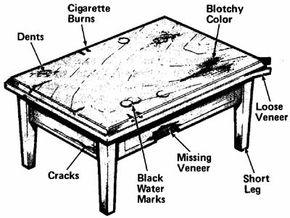Staining Wood Furniture Basics
Staining wooden furniture isn't just a matter of stripping off one finish and applying another. Preparing the wood takes both time and elbow grease, but it's vital to the success of your refinishing job. The finish is only as good as the preparation for it. You may end up spending more time on this step than you did on of the other furniture refinishing stages, but your results will be worth the effort.
Staining wooden furniture can be a big job, filled with the apprehension that you might ruin the piece. Hopefully, this article can give you peace of mind. In the following sections, we will walk you through the entire staining process -- bleaching, sanding, staining, and sealing. Let's get started with some questions you'll have to ask yourself before you begin staining.
Advertisement
First, take a good look at the piece of furniture. How has the stripping process affected it? Are the joints loose? Do burns, stains, or other blemishes still show? Are veneers loose or bubbled? Before you prepare and stain the wood, repair the damage. Any problems you ignore now will show up all too clearly later; the finish will accentuate the damage.
Second, look at the wood itself. What kind of wood is it? Is the grain open or closed? The type of wood determines the preparation -- open-grained woods should usually be filled; some woods may need special treatment. Is the piece of furniture made with more than one kind of wood? If it is, you may have to bleach or stain the less conspicuous wood -- usually the less expensive one--so that it matches the main surfaces.
Finally, look at the color and texture of the stripped wood. Is there an old stain or filler left in the wood? It should usually be bleached out. Is the color blotchy or uneven? Is one part of the furniture darker than another? Is the wood darker or lighter than you want it to be? Can you see a distinct grain pattern?
With any piece of furniture, the stain you choose will determine how the wood should be prepared. Not all finishes can be used with all sealers and fillers. Not all stains require the same amount of preparation. Before you prepare a piece of furniture for staining, make sure you're familiar with the special characteristics and requirements of the stain you plan to use. Read the ingredient and application information on the container, and follow the manufacturer's instructions and recommendations. Make sure you use compatible sealers and fillers as specified by the manufacturer and as outlined in the accompanying chart.
Think you're ready to begin? Well, before you can start staining or even sanding, you might have to do something about discolorations in the wood's surface. In the next section, you will learn the various techniques for bleaching wood.
